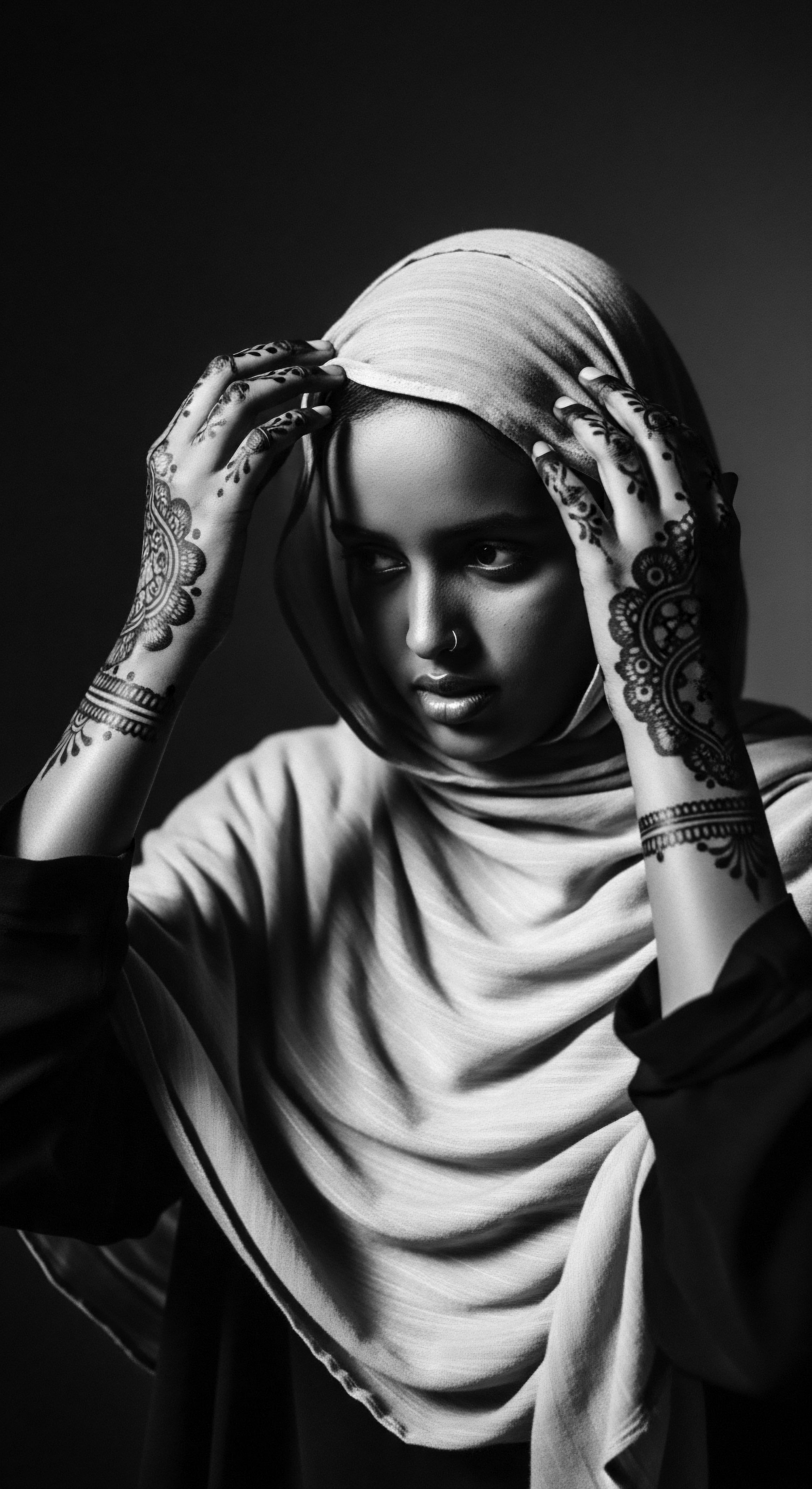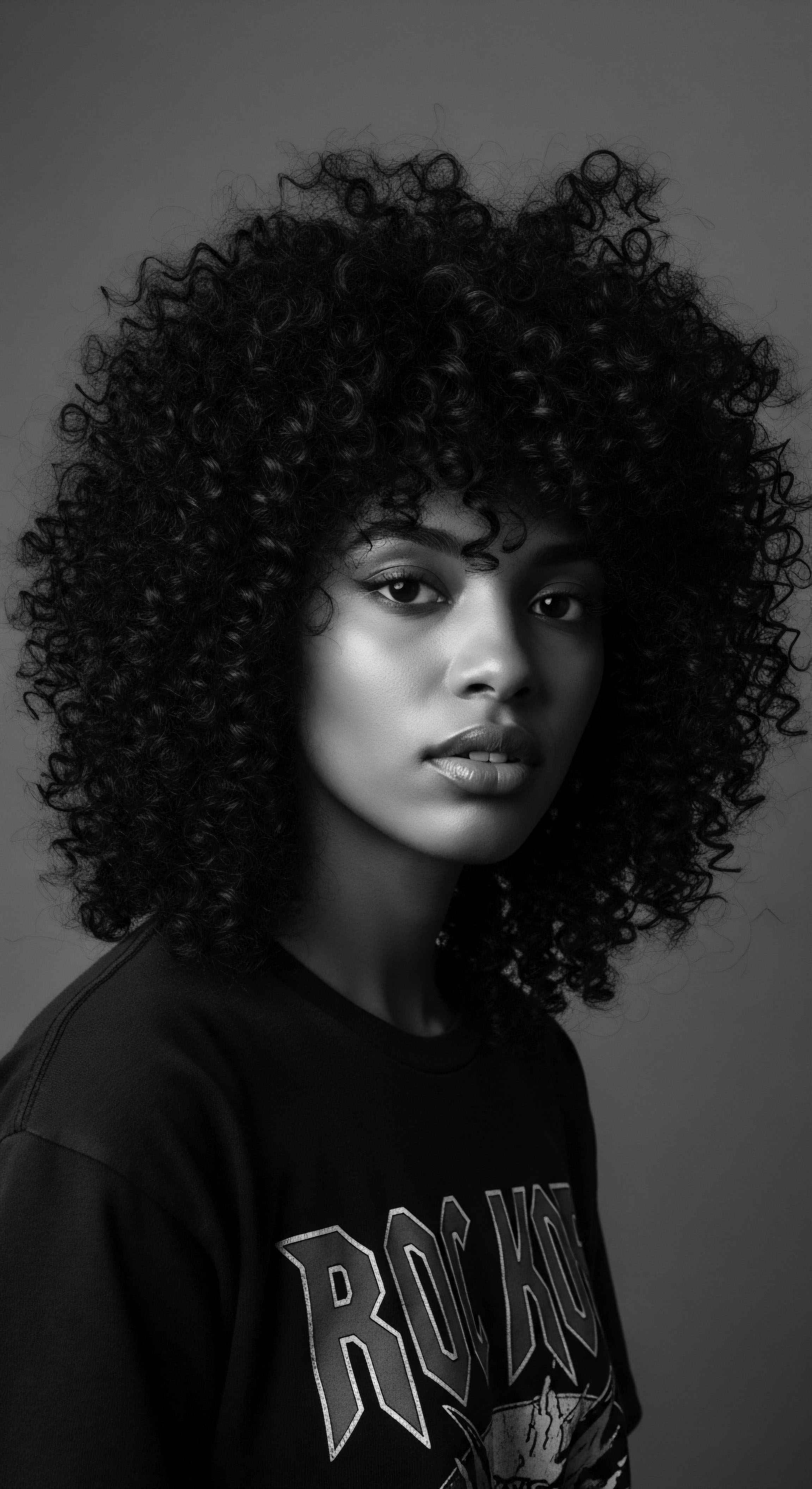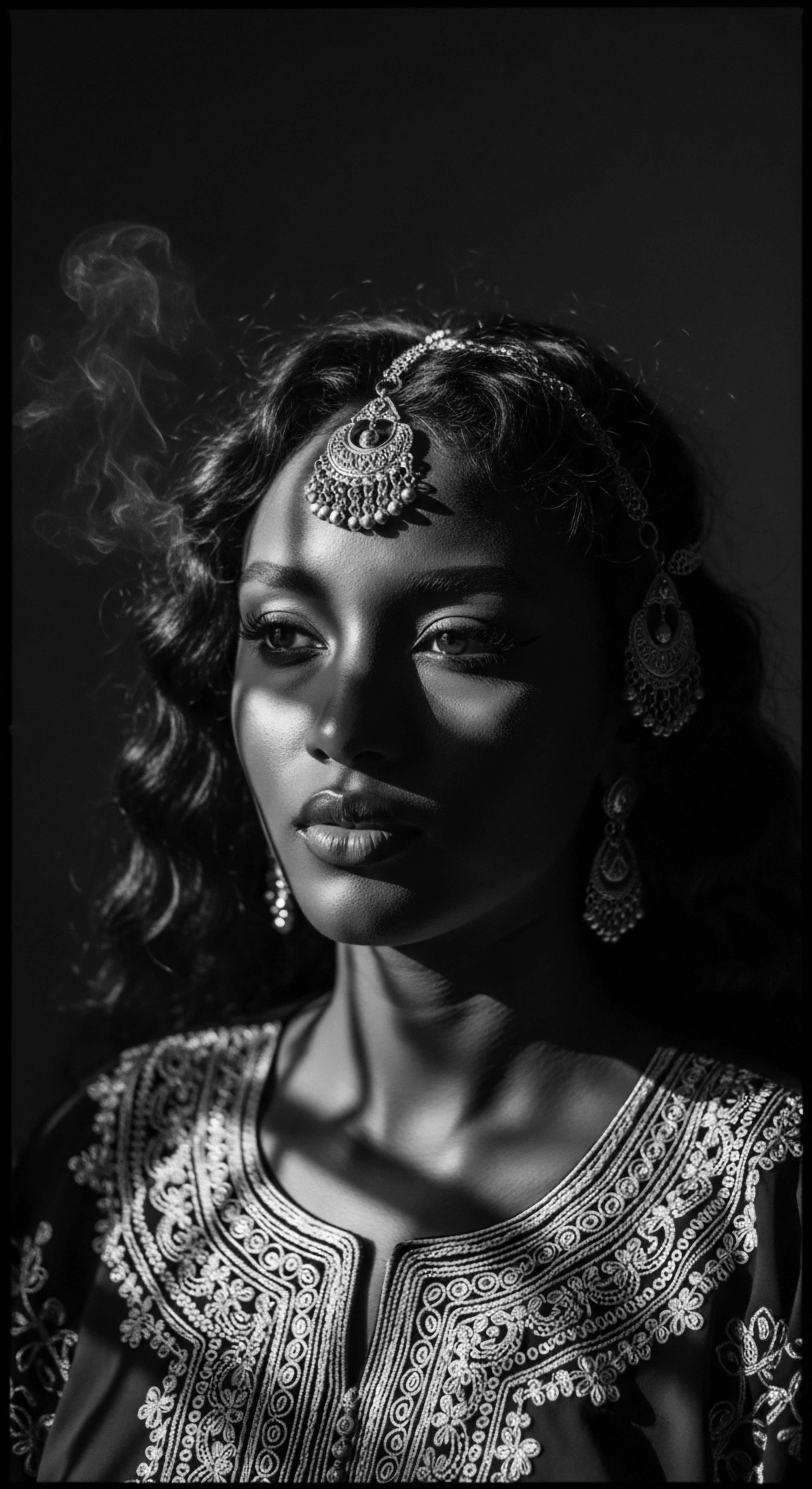
Roots
The journey into understanding textured hair biology begins not in laboratories, but in the echoes of ancient wisdom, in the deep communal memory of our forebears. For individuals of Black and mixed-race descent, hair is far from a mere adornment; it serves as a living, breathing archive of identity, a profound connection to ancestry. Each coil, every twist, holds stories of resilience, artistry, and deep knowledge passed down through generations. To truly grasp the ancestral understanding of textured hair biology, we must listen closely to these voices from the past, recognizing their intuitive scientific understanding long before microscopes revealed cellular structures.

Hair Anatomy Through Ancestral Lenses
Consider the intricate blueprint of textured hair. Its distinct Helical Pattern, often emerging from an elliptical follicle, was observed with keen eyes by our ancestors. They might not have termed it a ‘cortex’ or a ‘cuticle’, yet their daily interactions with these strands revealed their vulnerabilities and their strengths.
The tightly wound nature of many textured hair types, for instance, offers a natural defense against the sun’s intense rays, a biological advantage in equatorial climates. This innate UV protection, a recognized aspect of Ulotrichy Hair among indigenous African populations, suggests a practical, lived understanding of hair’s purpose beyond aesthetics.
Ancestral practices consistently point to an awareness of hair’s need for hydration and gentle manipulation. The intuitive knowing of how hair could dry or break speaks volumes about an unspoken understanding of the cuticle’s integrity and the hair shaft’s internal moisture balance. Observing hair’s reactions to different environments—its tendency to shrink in humidity, its brittle nature when parched—guided the development of sophisticated care rituals. These observations formed the basis for a holistic approach to hair health, recognizing its delicate composition and inherent requirements.

Ancestral Hair Classification Systems
Long before modern taxonomies sought to categorize hair by numbers and letters, ancestral communities possessed their own sophisticated, culturally significant ways of understanding hair. These systems were less about a universal scientific scale and more about identity, social standing, and spiritual connection. Hair was a communicative art form, a symbol that spoke volumes about an individual’s origins, marital status, age, or even their spiritual alignment.
In many pre-colonial African societies, hair types and styles were direct indicators of tribal affiliation. The Yoruba, for instance, used specific braiding patterns to convey social status. The way hair was manipulated, adorned, or presented was a language understood by all, a living record of community and self.
These systems, while distinct from modern biological classifications, demonstrated a profound awareness of the physical variations in hair and their social implications. This ancestral knowledge was rooted in direct observation and communal interpretation of hair’s appearance and its response to various manipulations.

Traditional Lexicon of Hair
The vocabulary used to describe hair within ancestral communities offers a window into their understanding. These words were not just descriptive; they were imbued with meaning, reflecting the cultural value and inherent qualities of textured hair. While exact terms vary across countless languages and dialects, common themes emerge ❉ words denoting strength, resilience, community, and beauty.
- Tignon ❉ A term referring to the headwraps Black women in Louisiana were forced to wear by law in the late 18th century. This law, despite its oppressive intent, inadvertently reinforced the cultural practice of head covering, which held prior significance in African societies.
- Osu ❉ Among the Yoruba people, a round patch of hair allowed to grow in the center or front of the head, sometimes styled like a pigtail (ere), often associated with priests of the Orisa Esu.
- Doek/Dhuku ❉ Headwraps traditionally worn in various African countries, serving as indicators of wealth, ethnicity, marital status, or even emotional state.

Hair Growth and Ancestral Influences
Ancestors lived in intimate connection with their natural environments. Their understanding of hair growth cycles, while not articulated in terms of anagen or telogen phases, was deeply practical. They observed patterns of shedding, growth, and hair’s response to nourishment.
Dietary practices, intrinsically linked to the available natural resources, played a fundamental role. Nutrient-rich diets, abundant in diverse plant-based foods and lean proteins, provided the foundational building blocks for strong hair.
Environmental factors were likewise intuitively managed. The sun, while providing warmth and life, could also be harsh. Tightly coiled hair itself offers some natural sun protection.
Head coverings were not just stylistic choices; they served as pragmatic shields against elements like dust, wind, and intense sun, preserving hair’s moisture and preventing damage. This practice reflects a deep, inherent understanding of hair’s vulnerability to environmental stressors and the biological imperative to protect it for optimal health and length retention.
The foundational understanding of textured hair biology rests on ancestral observation, where the hair’s very structure and responsiveness to environment guided profound care traditions.

Ritual
The ceremonial aspects surrounding hair in Black and mixed-race communities speak volumes about an ancestral understanding that extended beyond superficial appearance. Styling was never just about aesthetics; it was a profound act of care, connection, and communication, directly linked to the physical and social realities of textured hair. These practices, honed over centuries, reveal an intimate knowledge of how to manipulate, protect, and adorn hair in ways that honored its unique biology and cultural significance.

Protective Styling Heritage
What is the ancient wisdom underpinning protective styles? The multitude of protective styles that grace textured hair today are not modern inventions; many possess deep ancestral roots, some dating back millennia. Cornrows, for instance, have archaeological evidence tracing their existence to 3500 BCE in various African civilizations.
These styles were developed with an inherent awareness of the delicate nature of textured strands, particularly their propensity for dryness and breakage when exposed. By gathering the hair into braids, twists, or coils, ancestral communities safeguarded the hair shaft, reducing environmental exposure and minimizing daily manipulation.
This approach directly addressed biological realities ❉ hair encased in a protective style retains moisture more effectively, suffers less friction from clothing or elements, and experiences reduced mechanical stress from combing and styling. Such styles allowed hair to grow longer, stronger, and healthier. The meticulous planning involved in creating elaborate cornrow patterns, for example, often conveyed tribal affiliation, social status, or even served as visual maps for escape during periods of enslavement. This duality—practical biological protection alongside rich cultural meaning—is a cornerstone of textured hair heritage.
| Ancestral Style Braids and Cornrows |
| Traditional Significance Tribal identification, marital status, wealth, maps of escape, |
| Biological Benefit (Ancestral Observation) Reduced tangling, minimized breakage from manipulation, moisture retention, scalp protection |
| Ancestral Style Twists |
| Traditional Significance Symbolized tribe, social status, family background |
| Biological Benefit (Ancestral Observation) Gentle manipulation, less tension than braids for some, good for moisture application |
| Ancestral Style Bantu Knots |
| Traditional Significance Cultural heritage and beauty among Bantu-speaking groups |
| Biological Benefit (Ancestral Observation) Protection of hair ends, creation of curl definition without heat, minimal daily manipulation |
| Ancestral Style These ancestral styling methods reveal a profound, intuitive understanding of hair biology, prioritizing protection and sustenance. |

Natural Styling and Defining Techniques
The emphasis on natural texture has a lineage stretching back through time. Ancestral communities did not seek to alter hair’s intrinsic curl pattern but rather to enhance it, to allow its unique character to shine. Techniques for defining coils often involved natural ingredients and specific methods of application.
The use of natural oils, clays, and herbal infusions worked in concert with hair’s natural tendency to coil, lubricating the strands and minimizing frizz. These methods acknowledged the hair’s inherent need for external moisture, especially given its structural properties that make it more prone to dryness.
This approach stands in contrast to modern chemical relaxers, which alter the hair’s protein bonds. Ancestral practices consistently worked with the hair’s natural form, rather than against it, a testament to a deep respect for biological originality. The manipulation involved, often performed by skilled community members, was precise and gentle, further safeguarding the hair’s integrity.

Wigs and Hair Augmentation Through History
The wearing of wigs and hair extensions also has a compelling heritage in African cultures. It was not simply a fleeting fashion; it was a practice steeped in social, spiritual, and aesthetic meanings. Ancient Egyptians, for example, utilized wigs for hygiene, protection from the sun, and as symbols of status and beauty. These elaborate hairpieces often featured intricate braids and coils, mimicking the natural hair textures of the region.
Hair from relatives or plant fibers could be incorporated to add length or volume, speaking to a collective understanding of hair as a resource, something that could be integrated and transformed. This practice showcases an ancestral mastery of augmentation that understood how to add to the existing hair in ways that were both beautiful and, crucially, less damaging than some later methods of chemical alteration.
Styling in ancestral contexts was a holistic endeavor, simultaneously protecting hair’s biological structure while communicating vital cultural messages.

The Textured Hair Toolkit of Ancient Times
What do ancestral hair tools teach us about textured hair? The implements used for hair care in antiquity were crafted with remarkable precision, designed for the unique challenges and strengths of textured hair. Combs, for instance, were often made of wood or bone with wide teeth, ideal for detangling dense, coily hair without causing undue breakage. These were tools born of necessity and intimate knowledge of hair’s physical properties.
Adornments, too, were more than decorative. Beads, cowrie shells, and other natural elements were often braided directly into the hair, providing both beauty and sometimes practical benefits, such as adding weight or securing styles. The very act of applying these elements, often done communally, reinforced social bonds and transferred intergenerational knowledge about handling textured hair with the reverence it deserved. The materials chosen were often those found in the immediate environment, indicating a resourceful and sustainable approach to hair care that worked in harmony with nature.

Relay
The understanding of textured hair biology from an ancestral lens is not a static historical record; it is a living, breathing tradition, continuously relayed through generations. This deep current of knowledge informs holistic care practices and problem-solving approaches that resonate with modern scientific inquiry. It speaks to a profound intelligence that grasped the interconnectedness of hair health with overall wellbeing and the surrounding environment, long before contemporary research elucidated the precise mechanisms.

Building Care Regimens from Ancient Roots
How did ancestral wisdom guide holistic hair wellness? Ancestral care regimens were inherently holistic, recognizing that external hair health was a reflection of internal balance and environmental harmony. This approach contrasts sharply with purely symptomatic modern treatments.
Communities understood that hair’s vibrancy was tied to nutrition, to hydration, and to spiritual grounding. The selection of ingredients—natural oils, plant extracts, and clays—was based on centuries of empirical observation of their beneficial effects on scalp health and hair resilience.
For example, the Basara women of Chad have utilized a combination of herbs known as Chebe powder for centuries to sustain exceptionally long and strong hair. This traditional practice involves applying the powder, a blend of ingredients like cherry seeds, cloves, and lavender crotons, to the hair strands, thereby reducing breakage and moisture loss. Modern scientific inquiry corroborates the efficacy of certain plant-based ingredients in strengthening hair, preventing breakage, and enhancing moisture retention. This validation closes a circle, affirming the sagacity of practices passed down through oral tradition and lived experience.

The Nighttime Sanctuary ❉ Ancestral Bonnet Wisdom
The practice of covering hair at night holds profound cultural and practical significance within Black and mixed-race communities, extending far into ancestral history. Head coverings, known as dukus or doeks in various African countries, served multiple purposes ❉ reflecting status, identity, and often, protecting elaborate hairstyles during sleep. This was not merely a cultural custom; it was an intuitive act of biological protection.
Textured hair, by its very coiled nature, can be prone to tangling, frizz, and moisture loss during sleep due to friction with bedding. The ancestral use of headwraps and later, bonnets, mitigated these issues. These coverings created a protective barrier, reducing friction, preserving moisture, and helping to maintain the integrity of styled hair, thus preventing breakage.
The historical significance of the bonnet, particularly in the African American experience, evolved from a symbol of grandeur to a tool of subjugation during slavery, and ultimately, to an act of resistance and self-expression. Despite oppressive attempts to strip its meaning, the bonnet persisted as a vital tool for hair health and cultural continuity.
This enduring ritual demonstrates an inherent understanding of the physical vulnerability of textured hair and the methods necessary for its nocturnal preservation, ensuring its longevity and vitality.
- Silk/Satin Headwraps ❉ Traditional fabrics or those with smooth surfaces were likely favored for nighttime coverings due to their reduced friction, preserving moisture and preventing tangles.
- Pre-Sleep Oiling Rituals ❉ Applying natural oils before covering the hair provided an extra layer of protection, sealing in moisture during the resting hours.
- Sectioning Hair ❉ Before wrapping, hair was often sectioned or braided to prevent matting and simplify the morning detangling process.

Ingredient Deep Dives from Ancestral Gardens
The ancestral understanding of hair biology is perhaps nowhere more evident than in the meticulous selection and application of natural ingredients. These were not random choices; they were empirical findings from generations of observing efficacy.
Consider Shea butter , a staple across many West African communities. Its historical application for skin and hair health is well-documented, revered for its moisturizing and protective properties. Modern science now identifies shea butter as rich in fatty acids and vitamins A and E, confirming its capacity to provide hydration, create a protective barrier, and shield hair from environmental damage. This validates what ancestors knew intuitively ❉ certain plant-derived substances provided essential nourishment and a physical barrier to maintain hair’s delicate moisture balance.
Similarly, the widespread use of various plant oils, such as palm oil, coconut oil, and castor oil, speaks to an ancient knowledge of their emollient and strengthening qualities. These oils were used to lubricate the hair shaft, impart shine, and improve elasticity, which directly counters the natural dryness and fragility often associated with highly textured hair.

Textured Hair Problem-Solving with Ancient Remedies
What insights did ancestral practices provide for common hair concerns? Ancestors faced hair challenges much as we do today ❉ dryness, breakage, and scalp conditions. Their solutions, however, were deeply integrated with their environment and a holistic view of wellness.
Breakage, for instance, was addressed not just with external applications but by practices that minimized manipulation and protected the hair. The consistent use of protective styles, as discussed, reduced the mechanical stress that leads to breakage.
For scalp health, natural clays and herbal washes were likely employed, intuitively understanding their cleansing and balancing properties. The oral traditions often passed down specific plant concoctions for soothing irritated scalps or promoting healthier hair growth, reflecting centuries of trial and error and a refined understanding of botanical remedies. The very act of communal hair grooming also served as a preventative measure, allowing for early detection of issues and the sharing of traditional remedies. This ancestral problem-solving was characterized by its preventative nature and its reliance on natural, accessible resources.
The relay of ancestral knowledge has provided a robust framework for textured hair care, validating its wisdom through enduring practices and demonstrable biological benefits.

Reflection
As we traverse the vibrant history and intricate biology of textured hair, from the foundational knowledge of its structure to the protective rituals and resourceful remedies of our ancestors, a profound truth emerges. The ancestral understanding of textured hair biology was not codified in scientific papers or peer-reviewed studies. Instead, it was etched into daily life, spoken through the skilled hands of elders, whispered in the rhythm of braiding sessions, and seen in the flourishing crowns of generations. It was a wisdom born of deep observation, lived experience, and an unbreakable connection to the natural world.
This journey through Textured Hair Heritage reveals a continuous dialogue between the past and the present. Modern science, with its powerful tools, often arrives at conclusions that resonate with ancestral practices, thereby validating a knowledge system that has sustained communities for centuries. The helical complexity of a strand, its unique hydration needs, its vulnerability to friction, and its capacity for immense strength were understood, perhaps not through microscopic detail, but through the profound wisdom of consistent care.
This enduring legacy serves as a constant reminder that the soul of a strand is deeply intertwined with the collective spirit of those who have honored, adorned, and protected it through time. The journey of understanding textured hair is an ongoing celebration of this rich, living heritage, inviting us to carry forward these practices with both scientific insight and the reverence they inherently deserve.

References
- Byrd, Ayana, and Lori Tharps. Hair Story ❉ Untangling the Roots of Black Hair in America. St. Martin’s Griffin, 2001.
- Dabiri, Emma. Twisted ❉ The Tangled History of Black Hair Culture. Harper Perennial, 2020.
- Ellington, Tameka. Black Hair in a White World. Kent State University Press, 2020.
- Florence, Penny. Hair ❉ A Cultural History. Berg, 2004.
- Lucas, Alfred. Ancient Egyptian Materials and Industries. Edward Arnold, 1962.
- McMichael, Amy J. and Melissa Henderson. Hair and Scalp Diseases ❉ Medical and Surgical Approaches. CRC Press, 2012.
- Sieber, Roy, and Frank Herreman. Hair in African Art and Culture. Museum for African Art, 2000.
- Zviak, Charles. The Science of Hair Care. Marcel Dekker, 1986.
